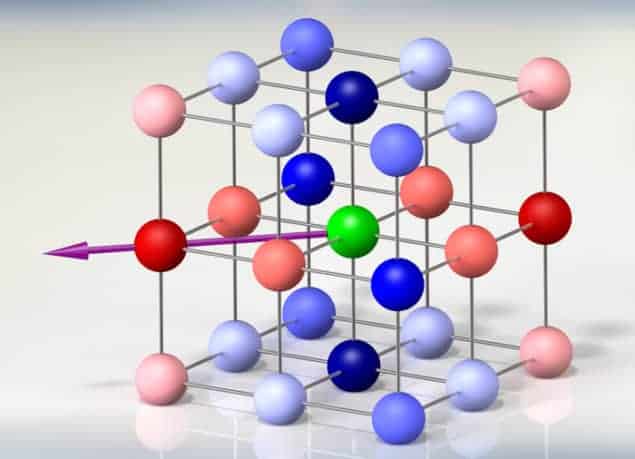
Physicists in the US have stored ultracold molecules in an optical lattice for the first time. The molecules – which interact with one another at a distance and not just at short range – could be used to study phenomena such as quantum magnetism, the researchers say.
When a system is cooled to a temperature very close to absolute zero, the underlying behaviour of its component parts is less erratic and it becomes possible to study their pure, quantum-mechanical interactions. For some three decades, physicists have studied ultracold atoms for this reason. However, many materials in nature are based on molecules, not atoms, and so physicists have been keen to study ultracold molecules too.
Unfortunately, cooling molecules is not straightforward. Unlike atoms, molecules have several ways of moving internally – such as vibrating and rotating – and this can all-too-easily hinder the cooling process. For instance, lasers are often used to cool atoms: an atom scatters a photon from a laser and in doing so loses energy. But try this with a molecule and the molecule might slip into an internal energy state that is “dark” to the laser, meaning that it cannot scatter photons – and cool – anymore.
Magnetic tuning
An alternative to cooling molecules directly is to cool a gas of atoms first and then encourage those atoms to bond into molecules. This was the route taken in 2008 by Deborah Jin and Jun Ye at the University of Colorado at Boulder and colleagues, who started with a cold gas of potassium and rubidium atoms. The researchers used a magnetic field to carefully tune the atoms into a certain state such that the atoms would form molecules when they collided with one another. The result was a gas of potassium–rubidium molecules at a temperature of just a few hundred nanokelvin and a density of one trillion molecules per cubic centimetre.
Now, Jin, Ye and colleagues at JILA – a joint institute of the University of Colorado at Boulder and the National Institute of Standards and Technology (NIST) – have gone one step further by trapping the ultracold potassium–rubidium molecules in an optical lattice. An optical lattice is made from laser beams that overlap to form a grid of potential wells in which atoms or molecules can sit. By trapping their molecules in an optical lattice, the researchers allow the dynamics of the molecules to be dominated by internal motion, rather than by side-to-side, translational motion.
Coupling spins
Thanks to their ability to rotate and their polar nature, the molecules can – in analogy with electrons – have two different “spin” states: up and down. By applying a microwave field to the optical lattice, the team could couple the spins of two distant (not neighbouring) molecules, so that a flip of one of the molecules caused the flip of another. Such long-range spin interactions underly quantum magnetism, which is responsible for the magnetism of everyday materials such as iron and may also play a role in superfluidity and high-temperature superconductivity.
Physicist Immanuel Bloch of the Max-Planck Institute of Quantum Optics in Garching, Germany, says the results are “very nice”, and praises the researchers for having shown that ultracold molecules can interact over a long range. “This is a very promising new route for realizing spin-models in ultracold quantum gases,” he adds.
Theorist Roman Krems of the University of British Columbia in Vancouver, Canada, calls the development a breakthrough. “This experiment paves the way for the design of quantum simulators of condensed-matter models,” he says.
The research is published online today in Nature.



